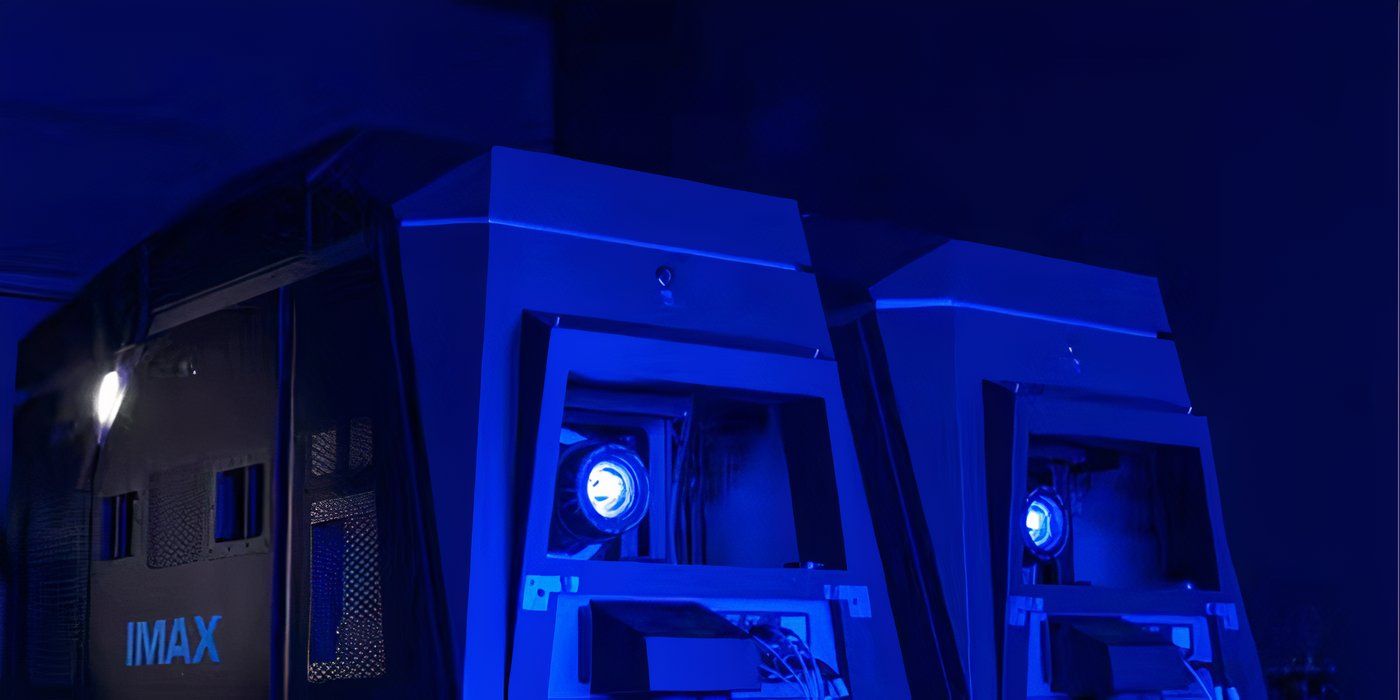The Big Picture
- IMAX is expanding globally with plans to double its network of theaters over the next six years, focusing on markets like Australia.
- A new generation of IMAX cameras is in development, with upgrades such as quieter and lighter features to enhance the filmmaker experience.
- IMAX is exploring the potential of live events, including TV series premieres like the one they recently did for a show by Jonathan Nolan, using IMAX cameras for a unique viewing experience.
These days, IMAX is synonymous with cinema and cinephiles, known for its breathtaking visuals and all-encompassing sound system. It conjures up ceiling-to-floor towering screens and probably also calls to mind certain filmmakers like Academy Award-winner Christopher Nolan, whose contributions to the format’s growth over the years are irrefutable. Because it’s ever-evolving and state-of-the-art, IMAX can feel new, but this technology first originated in the ’70s and has continued to provide moviegoers with unforgettable trips to the movie theater.
At this year’s Cannes Film Festival, Collider’s Steve Weintraub had the opportunity to speak with IMAX CEO Richard Gelfond and Chief Sales Officer Giovanni Dolci. The two of them sat down to discuss their mission to expand and oversee the success of IMAX across the globe and shared with us their six-year plan to get more audiences into more IMAX seats in the coming years. Gelfond, who’s been with the company since 1994, and Dolci share information about the new and improved IMAX cameras currently in development in the hopes of making the format more accessible to the filmmakers who embrace it.
Following the explosive success of Nolan’s Best Picture, Oppenheimer, and then again with Denis Villeneuve‘s sci-fi sequel, Dune: Part Two, IMAX is looking at a feast of a lineup for the next three years. They kicked off the summer of 2024 with Kingdom of the Planet of the Apes, going into the release of George Miller‘s prequel, Furiosa: A Mad Max Saga, and they’re only just getting started. According to Gelfond, 2025 is completely booked and 2026 is over halfway to capacity, with some filmmakers eyeing slots for 2027 already. In addition to this, we find out what IMAX has in store regarding live events, like the opening ceremony for the Summer Olympics, and television, like their IMAX premiere of Jonathan Nolan‘s Fallout series.
You can read the full transcript below to find out which IMAX locations Gelfond and Dolci recommend checking out and which blockbusters they’re most looking forward to seeing on the biggest screen. We also find out which movies were pivotal for IMAX, what re-releases they’re cooking up with A24, how they manage day-to-day issues, new developments, and tons more.
IMAX Expansion Plans Across the Globe
COLLIDER: I’ve wondered this for a while: will IMAX ever have more than one screen at a movie theater?
RICHARD GELFOND: In general, the answer is no. And the reason is that you could fill more than one screen only several times a year on big openings, but I think that during the bulk of the year and weekdays and off-days, the economics just don’t work out. I think what you’ll see instead is someone who owns a zone — so, think of AMC in Manhattan — they may build a second theater close by, like maybe at 85th Street, and even though there’s one at 68th Street, I think that’s a better model than putting two in the same compound.
In Los Angeles where you have a screen in Century City, you think that if AMC wanted, they could build another one nearby?
GELFOND: Yes. I think that’s a model that makes some sense. But I don’t think two in the same multiplex makes sense. We thought about this a lot over a long number of years.
What is the status of more IMAX screens around the world? Do you foresee in the next two to five years a doubling of IMAX screens, 30% more? Like in Australia there are very limited screens.
GELFOND: There’s only two.
That’s what I mean. So, what’s the status of more screens around the world and what area of the world do you think is going to get more sooner?
GIOVANNI DOLCI: We do an analysis that tells us what our total addressable market is in ideal conditions, and we believe in a six-year range in ideal condition, we could capture a total of 3,300-something screens. We could almost double the network in ideal conditions. We think that’s our addressable market. So, huge growth opportunity, and then it’s very market-dependent because you have the countries that are very well penetrated and mature, take North America to an extent, although there are some new players and opportunities, and some that are nowhere like Australia. I like that you mention that example because, if you ask me, our analysis is that in the next five years, we can get to almost 40 theaters in Australia in ideal conditions. I think it’s very realistic. The exact number, I believe, is 39.
Are those in active development right now or is this the hope?
DOLCI: No, no, it’s more than a hope. It’s what we think the market can sustain and what, based on our experience in comparable markets, we believe that IMAX can become in that particular market. We have very active discussions at the moment with a number of Australian exhibitors to deploy IMAX theaters. It’s an exercise, of course, to identify the right locations. We have some technical requirements looking at what future projects might be in the pipeline. It’s good that there is appetite, but that’s only part of the equation. We also want to study, for example, in a particular trading zone, what is the best option? Who is the best operator? What’s the best location? And we are doing that work now. I can tell you that I’m very confident that later this year, you will see some announcements or future developments in Australia that will take us closer to that number and will set the basis for future deployment there.
You both know everything about IMAX. If you had a choice of where to see one of your movies in one of your theaters on planet Earth, what is the theater you pick?
DOLCI: Oh, I’ve got too many, actually. My heart is close to the BFI IMAX in London because I live in London and that’s where I’ve been experiencing IMAX throughout the year. So I’ll give you a historic legacy one and then I’ll give you — allow me three — I’ll give you two new developments. One is Grand Cinema Sunshine in Ikebukuro in Tokyo, which is a brand new IMAX theater that opened just two or three years ago, which sits on top of a highrise. It’s just a crazy good development. And number three, I would put our most recent flagship opening, which is IMAX Sydney, which is amazing. All three of these, if I were close to one of them, would be my picks.
GELFOND: I would say Lincoln Square in New York, partly because it’s been there for so long and I just love it. I’m comfortable there.
A New Generation of IMAX Cameras Is Coming
You have nine IMAX film cameras, I believe, that currently get deployed, and I know you have new prototypes that are being worked on and new cameras coming. Do you foresee the nine film cameras that you have as the maximum number or do you see yourself making more of those types of large IMAX film cameras?
GELFOND: Well, we’re making four right now.
Those are the new prototypes?
GELFOND: The new prototypes. So it all depends on the demand and availability of film. Film is an older technology, so we’re looking at it on a broader basis. How can we make sure that film survives as a medium? But there’s always room for improvement, Steven. The new generation we’re making, they’re quieter, they’re lighter, but I’m sure as soon as we’re done inventing those, we’ll try and do the next generation. So, I would think there’d be more.
You mentioned there are four film IMAX cameras that are in the prototype stage right now. What is the difference between the four of them, or are they very similar?
GELFOND: No, the four are the same. But we’re working with well-known DPs and directors, as well, to design it in a way that’s more filmmaker-friendly.
I spoke to Hoyte van Hoytema and we had a great conversation about IMAX cameras, but I’m curious, how did you figure out how to make the cameras 30% quieter?
GELFOND: We tried to make them a lot quieter and for the time constraints and the money constraints, we could only achieve 30% now. But I’m sure there will be new materials, there will be other breakthroughs that are related, and I’m sure we’ll be able to make it even quieter in the future.
Christopher Nolan Has Boosted IMAX’s Growth Exponentially
I feel like Nolan and Oppenheimer reall put IMAX on the map in a way that it’s never been. He’s been building towards it his whole career, but this was a complete revolution where everyone knew: we see this movie in IMAX, IMAX film. Have you had more meetings, have you had more conversations because of the success of that film that will benefit IMAX and movie lovers over the next few years?
GELFOND: There are other moments in our history which have proven pivotal. One was when we did Disney’s Fantasia, another was when Avatar came out, and another one was Polar Express with Bob Zemeckis. But there’s no question that Oppenheimer and Nolan have boosted our growth curve. It’s very gratifying that almost every major important filmmaker in the world has initiated conversations about using IMAX cameras now. There’s no question that Oppenheimer, then followed by Dune, were the catalysts.
What is it like behind the scenes right now with all the people that want to get an IMAX release date and the limited number of screens and dates available? How far out as a company are you working on 2026 and 2027 right now?
GELFOND: We’ve committed to a lot of things for ‘26. So, the summer of ‘25 we can’t play another movie. For ‘26, I’d say about half of the summer is already committed and we’re discussing some projects for ‘27. But one of the most difficult parts of my job is how you could keep important filmmakers happy and at the same time, accommodate other people you want to accommodate. It’s a tough balancing act.
I know right now you guys are slammed, especially in 2025. You have so many amazing releases coming, but one of the things that I think a lot of cinephiles want is the ability to see older IMAX movies again in an IMAX theater. Are there any plans for, like, on Mondays and Tuesdays, or anything, that you can see an older 3D IMAX movie again or The Dark Knight, or another title?
GELFOND: We have a deal with A24 where we’re taking films out of their library, old films, and every two weeks or every month, we’re playing them. We’re kind of reformatting them and updating them so it looks good. We did a Queen concert from 40 years ago. We’re re-releasing Interstellar later this year. I think that’s a small business, not a big one, because you have to do a lot of marketing around it and we don’t have that many free dates. But it is a small initiative for us.
DOLCI: I would say it’s already happening to an extent. I will quote my beloved BFI IMAX theater, they often do re-releases. So it’s more about what the cinema operator feels that they can market and communicate. That’s a big piece when you do a very limited re-release: how do you tell people that they can go and watch it?
‘Joker: Folie à Deux’ Will Have the Same IMAX Run as ‘Dune 2’
Joker: Folie à Deux is getting an IMAX 70-millimeter film release. For fans, will it be on the same amount of screens Oppenheimer was on or will it be, like, five theaters?
GELFOND: It will be a dozen like Dune?
So it will be a selected limited release on 70-millimeter film?
GELFOND: Yes.
So like the big markets — New York, LA, London.
GELFOND: Yes. Pretty much the same markets that Dune 2 was on.
What kind of gifts do you guys get Chris Nolan on his birthday?
GELFOND: I don’t know if it’s related to his birthday, but every year around a big film, we do try and show our respect and thanks. So, I think when he wrapped up production on Oppenheimer, we commissioned a painting of an IMAX film camera and everyone at IMAX who is involved sent it and we delivered that to him. We’re about to deliver something, and all I can tell you is it’s based on a 70-millimeter projection, a unique design of something that we’re in the middle of getting ready to present to him. But I don’t want to spoil his surprise.

‘Oppenheimer’ Cinematographer Hoyte van Hoytema on IMAX, Not Using CGI, and Christopher Nolan’s Process
The Director of Photography also discusses what he geeks out over outside of work, what he’d change about IMAX, and shares surprising Nolan insight.
How important is it to you that future movies that are being done in IMAX are shot on IMAX film cameras versus IMAX digital cameras or IMAX-ready cameras?
GELFOND: I think it depends on the project. For very special movies, heavily filled with special effects, I think they’re better served on digital cameras because it’s easier to insert the computer graphics. But I think for certain kinds of stories — it’s kind of like vinyl. I grew up in the age of vinyl. I just love the resolution, I love the look and feel of it. So it depends entirely on the movie. And also, there’s a higher cost in film cameras, so I think the film cameras need to be reserved for something really special that’s gonna kind of jump out at you. Otherwise, just as happy to have it on digital cameras.
You announced a whole bunch of movies for 2025. Which of those films, if any, are being shot with IMAX film cameras?
GELFOND: Ryan Coogler is shooting the film that stars Michael B. Jordan on IMAX film cameras. I think there’s one or two others under discussion but they haven’t been announced yet, and there’s one for ‘26 that we’re starting to work on that’s going to be shot with IMAX film cameras.
For both of you, of your upcoming slate, which film are you most excited about that’s on an IMAX screen?
DOLCI: Joker 2.
GELFOND: He went too fast that time.
No debate.
GELFOND: But I’d say Joker also.
DOLCI: The vision behind it seems a perfect match for what we can offer in terms of canvas and just the experience.
GELFOND: I’ve seen some of it in IMAX and it’s spectacular.
I want to see Joker in IMAX 70-millimeter film, and I’m so lucky that I live in Los Angeles, but I think for a lot of fans who don’t live in a big market, that’s the one thing. They hear about it and they want to see it. We just have to get more IMAX screens.
GELFOND: That’s what Gio does, is make sure we have more screens all over the world to allow that to happen. The problem with film is that it’s a 50-year-old technology. When Chris Nolan started to shoot in black and white, Kodak had to bring engineers out of retirement to create black and white film. So, as much as I love film, few people love it as much as I do, there are certainly technical barriers because a lot of the knowledge and a lot of the technology is dated.
DOLCI: Given we are still at a relatively low penetration level, or very low in some markets, I think our priority mission is to get an IMAX theater to be able to serve as many people as possible. Like, I want to get a theater to someone who lives in Perth in Australia so they don’t have to spend hours on a plane to watch an IMAX movie. In my world, that’s a very important priority. And I acknowledge that there is a demand, also, for us to deploy film locations, but the urgency is actually to deploy IMAX locations.
Are There More IMAX Live Events in Our Future?
What is the status of more IMAX live events?
GELFOND: We’re looking at putting more events in general through IMAX, whether they’re filmed or alive. So again, the Queen concert or Taylor Swift are examples of film events that work very well. We’re doing a Beach Boys with Disney+ documentary that will have a live component to it. So I think when we initially went down this road, there was a great urgency to do them live. Now, there’s a great urgency to do them well. So, we don’t say, “Oh, this one we’ll only do it because it’s live.” The Olympics, which we’re doing, obviously the opening ceremony on the Seine is a live event which really needs to be live. So I think it depends on the kind of event rather than us singling out and saying, “We need X number of live events.”
DOLCI: For example, later this year we’re going to do Swan Lake in IMAX. That’s a pre-recorded event because we don’t think it has to be live, but pre-recorded allows us to shoot it with IMAX cameras. It will be the first opera ballet piece shot with IMAX cameras, which again, it’s important in terms of content diversity, but does it need to be live? We don’t think so.
GELFOND: Sporting events — we’re doing some NHL games and maybe some basketball games. I think sporting events need to be live. Other things, it probably depends on what they are.
Can We Please Get ‘The Last of Us’ Season 2 Premiere in IMAX?
Already, IMAX has hosted premiere screenings for series like ‘Fallout’ and ‘Demon Slayer’.
Television is more popular than ever, in terms of, like, Game of Thrones or Star Wars. There are certain TV shows that everyone is watching, and I’m so curious, have you ever had conversations about trying to make a season premiere or a season finale or certain television events that are massive into IMAX as an IMAX event one-night-only?
GELFOND: We’ve done it.
In the future, are you planning more?
GELFOND: Yeah. I mean, we just did one with Jonah Nolan. His new series was premiered in IMAX and it became one of the top series that Amazon has ever done. So, it worked for promotional reasons. In Japan we did [the Demon Slayer series] and they did it two years in a row, I think.
DOLCI: What they do, it’s actually quite interesting because you do the last episode of the previous season, followed by the first episode of the new season in IMAX as a two-hour event.
Are you having a lot of conversations with anyone about doing more of these in the future? For me, like with House of the Dragon, I would pay to go see that on an IMAX screen. There are certain shows that I would do this.
GELFOND: So the answer is yes. We have ongoing discussions about doing it with some other things. But back to Demon Slayer, not just in the US, but globally — remember, two-thirds of our network is outside of the US, so there’s lots of people to talk to about that idea and we’re having some discussions.
IMAX Will Utilize AI to Continue to Improve
What is the next thing coming to IMAX theaters in terms of digital technology or technology that your guys are working on behind the scenes, whether it be a stronger bulb or a lens, or things that I wouldn’t know to ask? Are you working on those kinds of things?
GELFOND: We are. We are very focused on utilizing artificial intelligence to create better experiences for the viewers. So as you know, we monitor every theater in the world in real time and we have reams of data coming in, only some of which we use and others of which it’s just too much to analyze. So we’re working on a project where we can use that for more predictive ability so we can say, “How long is a bulb going to last,” or, “Where should we move our inventory?” So, to increase the uptime of the network and increase the user experience, that’s one significant thing. We’re also looking at tools that could help us market better. I see if somebody’s playing not enough shows, too many shows, and help us manage our business that way. Also, we’ve been working on a product to extend the life of some of our lasers for our laser projection system. So, we have a lot of things going on.
DOLCI: There is way more that happens behind the scenes than what we disclose to the general public. For example, on the projection systems, we do constant tweaks and iterations of the system. There is a reason why we don’t disclose what we do because we don’t want to create an idea whereby a theater has a newer generation system than the others. We aim at having IMAX being the best in class, so IMAX is IMAX. But we constantly improve. We go and do software patches to the systems. We don’t want people to get entangled in the minutia of it, but there is a constant war.
I love the fact that your system is being monitored. It’s one of the reasons IMAX is IMAX. What ends up being the thing that you guys are always tweaking in the network? Is it making sure the bulb is up to snuff? Is it the volume? What is the thing that you guys are always calling someone about?
DOLCI: There is not one thing, actually. So, bulbs, for instance, it’s the prior generation technology now. All the systems that we deployed now since a couple of years ago are all laser-based. That’s one of the beauties of laser: you have a constant light throughput, so you just have to retune the system on a daily basis. Also, part of our technology was to make sure that the bulb was driven less in its infancy so they are overspeced so you drive less power to the bulb in the first period, so you now then increase the power so that the light output remains constant. So, it’s something that the system does on its own. Then, at some point, it’s a cut-off point and they operator has to change the bulb.
On the typical things that we pick up, I think the most important element is this daily calibration that the theaters have to do. So when any theater powers up for the day, the IMAX theater recalibrates itself. There is a high-spec camera in the projection booth that picks up a pattern onscreen and redoes the brightness, the color calibration. And then there are microphones in the room that recalibrate the sound. When that process doesn’t happen, it’s probably the most frequent red flag because maybe there is an issue in opening time. It doesn’t happen frequently. It might happen once a year in a theater, but if I think about what the issues flagged are, that theater for some reason didn’t do the daily calibration so something might be slightly out of spec. Then we call up and say, “Guys, we have a problem here. The theater is not operating as it should. Recalibrate, please. Do a break in between shows.”
GELFOND: One thing people wouldn’t think about is the sound would be tuned very differently for a theater that’s one-third filled versus a theater that’s completely filled. The sound dynamics are very different. So by recalibrating before shows and every morning, you really maximize the experience for your audience.
DOLCI: That’s essential, especially because we need our systems to perform exactly the same because that’s what allows us to produce a master of the movie that pushes every parameter to the boundaries. Whereas, a studio needs to output a DCP that works as good as it can on a wide array of systems. You cannot master it too bright for certain systems or too dark for others. We need to know exactly how the system performs because that master then is perfectly tailored to that system. That’s, I think, a key part of a secret recipe.

‘Oppenheimer’ Helped Boost IMAX Profits by 50%
Who’d’ve thought?
Nolan told me that with Oppenheimer he reached the maximum film platter that a movie can be for an IMAX film. At the moment with Oppenheimer, because of reaching the maximum limit, are you discussing ways to make an IMAX film platter bigger, or is the time of Oppenheimer the maximum of what IMAX film will be going forward?
GELFOND: For now, yes. We’re not looking at any project to make it longer. And by the way, this won’t surprise you, the studios and exhibitors love that that’s the maximum runtime. So we have no pressure on that.
Keep an eye on Collider for even more IMAX announcements and screenings.








